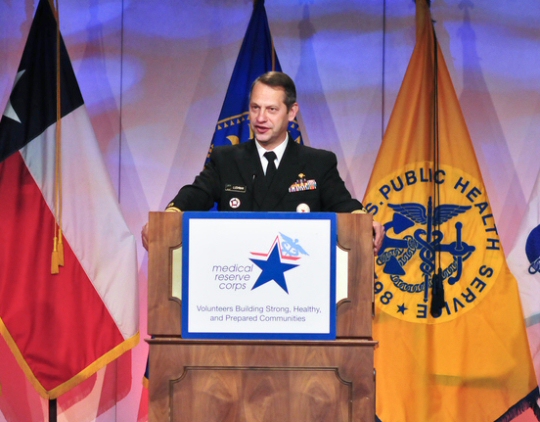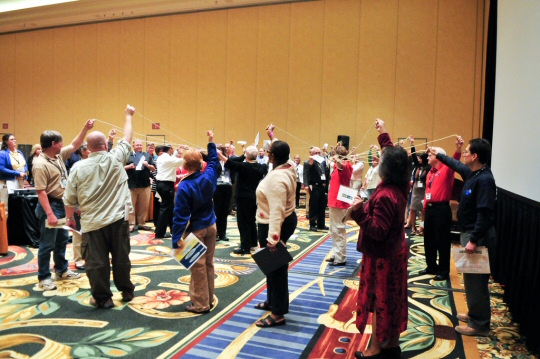Volume 7, No. 7 June 13, 2011
In Brief...
Prior Issues...
- 2008
- 2007
- 2006
- 2005
- 2014
- 2013
- 2012
- 2011
- 2010
- 2009
PDF Archives
- 2000
- 1999
- 1998
- CC Bulletin Supplements
- 2005
- 2004
- 2003
- 2002
- 2001
On May 1-5, 2011, Commissioned Corps of the U.S. Public Health Service (Corps) officers from across the nation participated in the 2011 Integrated Medical, Public Health, Preparedness and Response Training Summit sponsored by the U.S. Department of Health and Human Services (HHS). Often referred to as the Integrated Training Summit (Summit) by participants, this annual event is a partnership between Emergency Support Function 8 (ESF #8) resources to include the National Disaster Medical System (NDMS), the Medical Reserve Corps (MRC), the Emergency System for Advance Registration of Volunteer Health Professionals (ESAR-VHP), and the Corps; Office of Force Readiness and Deployment (OFRD). This year’s Integrated Training Summit was held at the Gaylord Texan Hotel in Grapevine, Texas with over 2,700 attendees.
The Summit provides a forum for coordination, collaboration and interaction between leaders and members of the partner programs NDMS, MRC, ESAR-VHP and Corps OFRD. Recognized experts in public health and medical preparedness and response, including a number of Corps officers, provided Summit participants with key insights and the latest information in five focus areas: healthcare systems and clinical care services, leadership, public health, resource management and patient movement, and response integration.
Presentations in the healthcare systems and clinical care services focus area highlighted healthcare system efforts to plan for, respond to, and recover from a wide variety of events, ranging from mass casualty incidents to public health emergencies. Emphasis was placed on the need for coordination and integration of organizations involved in these emergencies. This focus area also featured sessions on both physical and psychological clinical care of patients and responders.
Effective leadership is a critical commodity in the public health and medical preparedness and response field. Presentations in the leadership focus area addressed the principles of strategic leadership including goal-setting, team development, program planning and evaluation. The issues associated with tactical leadership such as team dynamics, effective communications, and the welfare of responders were also addressed.
The public health focus area addressed public health concerns at the local, state, federal and international levels with session encompassing the various viewpoints of public health. Highlighted during sessions in this focus area were efforts to improve the health of the nation, including healthy living for responders and building public health resiliency through ongoing community initiatives. Presentations in this focus area also addressed cross-cultural care, international public health outreach missions and the “One Health” framework involving collaboration among public health, EMS, behavioral health, veterinary medicine, and other health-related disciplines to address health-related issues and challenges.
The resource management and patient movement focus area covered a wide variety of topics, such as emergency management challenges and ethical considerations resulting from limited or unavailable resources as well as the various resources available at each level of response to include at the local, state and federal level. An overall theme of this focus area was the need for relationships and integration of various ESF #8 partners in order to meet response requirements. This focus area also addressed the challenges and considerations in patient and evacuee movement processes particularly involving at-risk and vulnerable populations including patient as well as evacuee tracking and information sharing. Best practice procedures to obtain, deploy and sustain resources were also shared.
The presentations in the response integration focus area provided participants with an overview of domestic and international response operations and highlighted best practices related to the coordination, integration and collaboration between local, state, tribal, and Federal organizations. This focus area emphasized coordination and integration as key concepts in emergency management and are essential to effective public health and medical emergency operations.
Highlights of the 2011 Integrated Training Summit included:
Next year’s Integrated Training Summit will be held during May 2012 in Nashville and will build upon the 2011 theme of Integration Across Borders, Moving Forward Together and continue to improve the skills and broaden the knowledge of our nation’s health and medical responders while strengthen the connections between them. In doing so, the Integrated Training Summit will continue to enhance emergency preparedness, response capacity and resiliency of our communities, our states and our nation.


The Summit provides a forum for coordination, collaboration and interaction between leaders and members of the partner programs NDMS, MRC, ESAR-VHP and Corps OFRD. Recognized experts in public health and medical preparedness and response, including a number of Corps officers, provided Summit participants with key insights and the latest information in five focus areas: healthcare systems and clinical care services, leadership, public health, resource management and patient movement, and response integration.
Presentations in the healthcare systems and clinical care services focus area highlighted healthcare system efforts to plan for, respond to, and recover from a wide variety of events, ranging from mass casualty incidents to public health emergencies. Emphasis was placed on the need for coordination and integration of organizations involved in these emergencies. This focus area also featured sessions on both physical and psychological clinical care of patients and responders.
Effective leadership is a critical commodity in the public health and medical preparedness and response field. Presentations in the leadership focus area addressed the principles of strategic leadership including goal-setting, team development, program planning and evaluation. The issues associated with tactical leadership such as team dynamics, effective communications, and the welfare of responders were also addressed.
The public health focus area addressed public health concerns at the local, state, federal and international levels with session encompassing the various viewpoints of public health. Highlighted during sessions in this focus area were efforts to improve the health of the nation, including healthy living for responders and building public health resiliency through ongoing community initiatives. Presentations in this focus area also addressed cross-cultural care, international public health outreach missions and the “One Health” framework involving collaboration among public health, EMS, behavioral health, veterinary medicine, and other health-related disciplines to address health-related issues and challenges.
The resource management and patient movement focus area covered a wide variety of topics, such as emergency management challenges and ethical considerations resulting from limited or unavailable resources as well as the various resources available at each level of response to include at the local, state and federal level. An overall theme of this focus area was the need for relationships and integration of various ESF #8 partners in order to meet response requirements. This focus area also addressed the challenges and considerations in patient and evacuee movement processes particularly involving at-risk and vulnerable populations including patient as well as evacuee tracking and information sharing. Best practice procedures to obtain, deploy and sustain resources were also shared.
The presentations in the response integration focus area provided participants with an overview of domestic and international response operations and highlighted best practices related to the coordination, integration and collaboration between local, state, tribal, and Federal organizations. This focus area emphasized coordination and integration as key concepts in emergency management and are essential to effective public health and medical emergency operations.
Highlights of the 2011 Integrated Training Summit included:
- Keynote presentations by the USPHS Surgeon General and senior HHS leaders
- Response Team Leader Training for all 41 OFRD Response Teams
- Remarks by cartoonist, humorist and paramedic Steve Berry
- Almost 80 poster presentations
- Partner organization displays
- 5K walk/run and yoga session
Next year’s Integrated Training Summit will be held during May 2012 in Nashville and will build upon the 2011 theme of Integration Across Borders, Moving Forward Together and continue to improve the skills and broaden the knowledge of our nation’s health and medical responders while strengthen the connections between them. In doing so, the Integrated Training Summit will continue to enhance emergency preparedness, response capacity and resiliency of our communities, our states and our nation.

RADM Lushniak addressing the Medical Reserve Corps program during the Office of the Civilian Volunteer Medical Reserve Corps Awards program.

The MRC federal deployment cadre learning the various components and relationships involved in an ESF 8 response utilizing a rope model.



